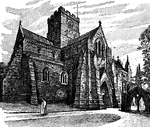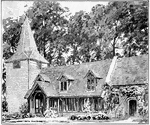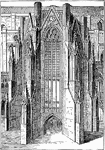Clipart tagged: ‘parish sanctuary’

Buildwas Abbey (Cistercian)
The Cistercian Abbey of St Mary and St Chad was founded in 1135 by Roger de Clinton, Bishop of Coventry…

Norman Door, Canterbury Cathedral
After the Norman conquest in 1066, Lanfranc (1070-1077) became the first Norman archbishop. He thoroughly…

Carlisle Cathedral
It was begun during the reign of King Henry I by the first Bishop of Carlisle, the Englishman Athelwold…

Durham Cathedral
Founded in AD 1093, it remains a centre for Christian worship today. It is generally regarded as one…

Durham Cathedral from the Wear
Founded in AD 1093, it remains a centre for Christian worship today. It is generally regarded as one…

Ely Cathedral
Ely Cathedral (in full, The Cathedral Church of the Holy and Undivided Trinity of Ely) is the principal…

Fugitive Claiming Sanctuary
Sanctuary was also a right to be safe from arrest in the sanctuary of a church or temple, recognized…

Greenstead Church
Greensted Church, in the small village of Greensted, near Chipping Ongar in Essex, England, is the oldest…

Lincoln Cathedral
It was the tallest building in the world for over 200 years (1300-1549), but the central spire collapsed…

Chapter House of Old St. Paul's
Old St. Paul's is a name used to refer to the Gothic cathedral in the City of London built between 1087…

St. David's Cathedral
The monastic community was founded by Saint David, Abbot of Menevia, who died in AD589. Between AD645…

St. Sepulchre's, Cambridge
The original Saxon church on the site was dedicated to St. Edmund the King and Martyr. During the Crusades…

Tintern Abbey, Cisternian
Tintern Abbey was founded by Walter de Clare, Lord of Chepstow, on May 9, 1131. Situated on the River…

Transept of the Martyrdom at Canterbury Cathedral
The transept is the area set crosswise to the nave in a cruciform ("cross-shaped") building in Romanesque…